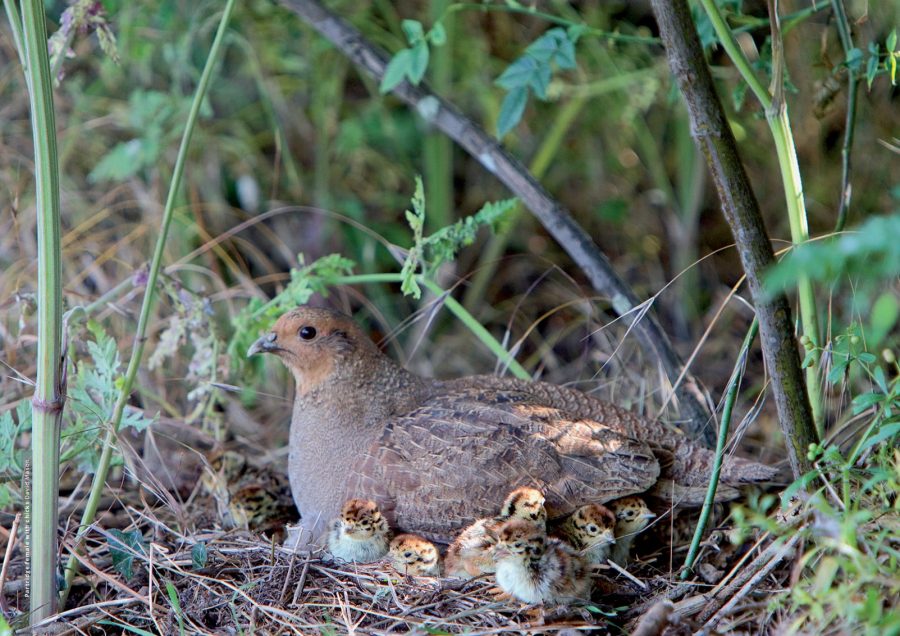“On the first day of Christmas my true love sent to me… a partridge in a pear tree!”
We all know the words to one of our most beloved Christmas songs, and many of us also know that finding a partridge in a pear tree is extremely unlikely.
These little plump birds – an iconic part of our farmed arable landscape – are much more at home on the ground. Duringthe winter months, they are mostly hiding in the winter stubbles, rape fields and wildbird seed mixes, or along the hedgerows.
Grey partridges are found in open farmland and pasture, from Scotland to the south-west of England, and along the moorland fringes of northern England. During this time of year, they live in tight groups, or ‘coveys’ of up to 20 birds. With their little orange faces and round grey-brown bodies they are both distinctive, and quite comical, in appearance.
 What you might not know is that time is fast running out for our native grey partridge!
What you might not know is that time is fast running out for our native grey partridge!
When the lyrics of 12 Days of Christmas were penned more than 250 years ago, farmers’ fields across Britain were brimming with grey partridges. It was once one of the most prolific farmland birds, the mainstay of small game shoots, and part of the staple diet of country folk, who typically would poach them at night.
Since the early 1980s, numbers have dropped by 94%, data from the Game & Wildlife Conservation Trust (GWCT) has shown. Back in 1911 there were more than a million breeding pairs in the UK – today we have fewer than 37,000 pairs. It is the steepest and most dramatic decline of any bird species in the UK, after the turtle dove.
The decline has been attributed to a number of factors including the intensification of agriculture, especially the shift from small-scale mixed farming to large-scale winter cropping, and increases in pesticide use reducing insect food for partridge chicks.
Widely regarded as a ‘barometer’ of the countryside, the grey partridge is also an umbrella species: If the partridge is struggling, other farmland species are suffering too.
But, in the words of Francis Buner, GWCT Head of Wildlife recovery and international grey partridge expert: “If we turn the tide and do what is right for the grey partridge, we will also do what is right for farmland biodiversity.
“Where grey partridges thrive, bees, birds, mammals and anything that’s crawling on the ground typically also thrives.
“I have never met anyone who doesn’t like the humble grey partridge. They are therefore the perfect flagship species to work with and can unite any stakeholder around the table to draw up a conservation plan.
“We therefore believe that conservation action directed towards the grey partridge is the best and most efficient way to restore farmland biodiversity generally.”
From children’s game to Christmas carol
First published in 1780 in the children’s book Mirth without Mischief, 12 Days of Christmas was a rhyme that was sung as part of a game. The leader would kick things off by singing ‘On the first day of Christmas…’ which was then repeated by the next player who added another verse.
Fast forward 250 years and this is now one of our most beloved carols sung by young and old this time of year.
In another 250 years we will probably still be singing … “and a partridge in a pear tree!”
But by then the sight and sound of real grey partridges in the fields and along the hedgerows might just be a memory of bygone days – unless we act now!
Here is how you can help grey partridges thrive on your land!
The GWCT also runs the voluntary Partridge Count Scheme which farmers, gamekeepers and landowners can join to help collect information on the annual abundance and breeding success of grey partridges across the UK. This also helps them see the effects of their own conservation efforts.
You can also follow the story on Facebook and Twitter over the festive season with our 12 Days of Christmas – Partridge Fact of the Day.
Help the Game & Wildlife Trust make 2024 the year of the partridge!
More news like this can be found in The Country Smallholder magazine. Subscribe here.
For FREE updates from the world of smallholding, sign up for The Country Smallholder newsletter here.








